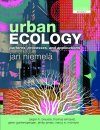![Urban Ecology Urban Ecology]()
Click to have a closer look
About this book
Contents
Customer reviews
Biography
Related titles
About this book
Urbanization is a global phenomenon that is increasingly challenging human society. It is therefore crucially important to ensure that the relentless expansion of cities and towns proceeds sustainably. Urban ecology, the interdisciplinary study of ecological patterns and processes in towns and cities, is a rapidly developing field that can provide a scientific basis for the informed decision-making and planning needed to create both viable and sustainable cities.
This volume brings together an international team of leading scientists to discuss the current understanding of all aspects of urban environments, from the biology of the organisms that inhabit them to the diversity of ecosystem services and human social issues encountered within urban landscapes.
Contents
Introduction
The History of Urban Ecology
SECTION 1 - ECOLOGY IN CITIES: MAN-MADE PHYSICAL CONDITIONS
Introduction to Section 1
1.1 Land Use and Surface Cover as Urban Ecological Indicators
1.2 Urban Climate
1.3 Urban Soils - Characterization, Pollution and Relevance in Urban Ecosystems
1.4 Hydrology of Urban Environments
Summary of Section 1
SECTION 2 - ECOLOGY IN CITIES: PATTERNS OF URBAN BIODIVERSITY
Introduction to Section 2
2.1 Plant Communities of Urban Wetlands: Patterns and Controlling Processes
2.2 Potemkin Gardens: Biodiversity in Small Designed Landscapes
2.3 Vegetation of Urban Hard Surfaces
2.4 Composition and Diversity of Urban Vegetation
2.5 Anthropogenic Ecosystems: The Influence of People on Urban Wildlife Populations
Summary of Section 2
SECTION 3 - ECOLOGY IN CITIES: PROCESSES AFFECTING URBAN BIODIVERSITY
Introduction to Section 3
3.1 Coupled Relationships between Humans and other Organisms in Urban Areas
3.2 Urban Flora and Vegetation: Patterns and Processes
3.3 Effects of Urbanisation on the Ecology and Evolution of Arthropods
3.4 Effects of Urbanisation on the Ecology and Evolution of Reptiles and Amphibians
3.5 Biodiversity and Community Composition in Urban Ecosystems: Coupled Human, Spatial, and Metacommunity Processes
Summary of Section 3
SECTION 4 - ECOSYSTEMS, ECOSYSTEM SERVICES, AND SOCIAL SYSTEMS IN URBAN LANDSCAPES
Introduction to Section 4
4.1 Global Effects of Urbanization on Ecosystem Services
4.2 Social-Ecological Transformations in Urban Landscapes - A Historical Perspective
4.3 The Urban Landscape as a Social - Ecological System for Governance of Ecosystem Services
4.4 Water Services in Urban Landscapes
4.5 The Role of Ecosystem Services in Contemporary Urban Planning
Summary of Section 4
SECTION 5 - URBAN DESIGN, PLANNING, AND MANAGEMENT: LESSONS FROM ECOLOGY
Introduction to Section 5
5.1 Urban Ecology - the Bigger Picture
5.2 Urban Ecology and Human Health
5.3 Multifunctional Green Infrastructure Planning to Promote Ecological Services in the City
5.4 Building for Biodiversity: Accommodating People and Wildlife in Cities
5.5 Linking Social and Ecological Systems
5.6 Building Urban Biodiversity through Financial Incentives, Regulation, and Targets
Summary of Section 5
Overall summary
References
Index
Customer Reviews
Biography
The Editor-in-Chief, Jari Niemelä, is professor of urban ecology at the University of Helsinki, Finland. His research interests include urban ecology, biodiversity, interactions between ecological and social systems, and the application of ecological knowledge in decision-making.
The section editors Jurgen H. Breuste, Thomas Elmqvist, Glenn R. Guntenspergen, Philip James, and Nancy E. McIntyre are leading researchers in this field.


































